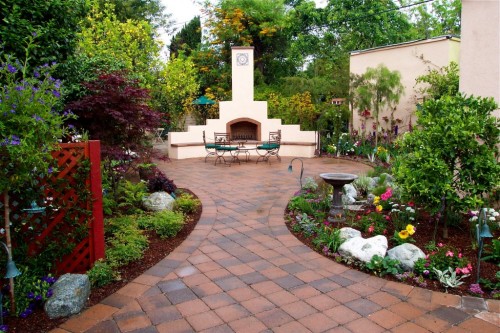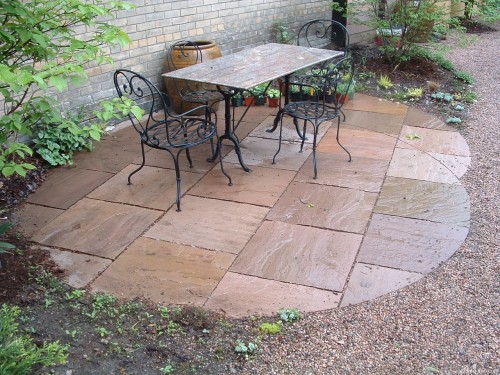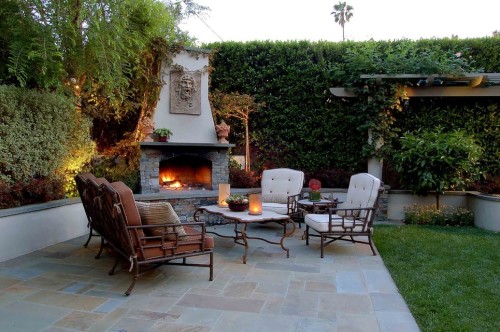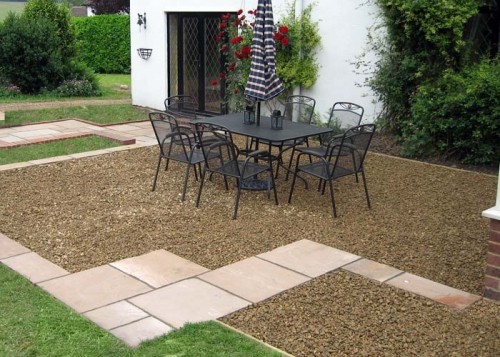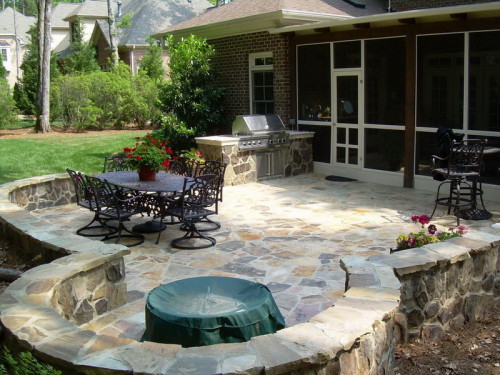Patio is an equipped courtyard on the territory of the site. The presence of such a site makes it possible to increase the useful area, and it is also profitable to supplement the landscape design. There are many options for using Patio. It can be a place for games, a recreation area, a premises for receiving guests or just a place where you can relax and accept sunbathing.
Content
Planning stage
The initial stage of the development of Patio is planning. At this stage, it is necessary to provide such nuances as:
- the purpose of the site;
- place of its location;
- type of coating;
- decor elements.
To have a clear idea of \u200b\u200bthe future site, you should draw its plan, using millimeter paper. In the planning process, it is important to provide for the rational use of decorative elements.
If you use only one type of coating without the use of decorative parts when arranging a large patio in the country, in this case the site will have a boring and non -original appearance. But at the same time, in the desire to diversify the patio with various elements, the measure should be observed. Too many decorative details, especially on a small site, will also look unattractive. To verify the correctness of the selected size, you can mark the site using the cord and pegs, because This will allow the visualization of the future site.
Patio photo:
Determination of sizes, places and choice of material
Let us consider in more detail each of those points that must be foreseen at the planning stage.
- The sizes of the patio directly depend on its purpose. If you plan to use the site only for relaxation, its dimensions can be small. In this case, it will be enough to place a table and chairs on the coating.
- If the courtyard is equipped with the aim of receiving guests, it is necessary that it be a fairly large site. In this case, all guests will feel comfortable.
- In addition to these criteria, when determining the parameters of the site, the size of the garden should also be taken into account. A small patio on a large site will look completely inharmonious, like a large platform on the territory of a small garden. There are recommended dimensions –3.5 m 2 for one person.
Next, you need to decide on the place. It is recommended to take into account the nuances such as: protection from the wind and the lighting of the sun. Also, for a comfortable stay on the site, patronage from prying eyes plays an important role. It is not recommended to have a patio near large trees - linden, willow or poplar. Since in this case there will be a need to regularly cleanse the site from leaves. You should also determine the shape of the site. The most common forms are a square, rhombus and a rectangle. As a rule, such patio is equipped near the house, since straight lines are successfully combined with the lines of the building. Far from the house, Patio may have the wrong shape.
When choosing the material, you need to proceed from the following criteria:
- Patio of bulk materials, for example, gravel, crushed stone or crushed bark, should not be used for backfilling. Also, cobblestone and paving stones are not suitable, since walking on such a site will be extremely inconvenient.
- The selected material should be combined with the paths available on the site and the main structure.
- Concrete slabs will be a suitable choice for the site. The combination of squares of square and rectangular shape will allow you to get an extraordinary interesting coating. But designers do not recommend forming a chess order from these plates.
- For those who prefer abstract forms and images, a mosaic will be a suitable choice. It can be either from a stone of natural origin, and from broken concrete slabs. Extraordinary outlines can be performed from paving brick.
- For Patio, stone slabs and concrete tiles are also used. Along with stone materials, wood is also widely used. For the arrangement of sites, wooden shields are usually used with parameters of 60x60 cm, made of boards. The minimum service life is 20 years, in addition, such shields are comparable to other materials that differ in ease of installation.
Technological features of construction
To arrange a patio in a summer cottage is a task feasible for any homeowner. However, for this it is necessary to adhere to certain subtleties, which will be discussed below. In addition, the following set of tools and materials should be prepared:
- level;
- bayonet shovel;
- construction car;
- paving stones;
- sand;
- tamping tool;
- hammer.
The process of arranging Patio with your own hands looks like this:
- The construction of the site must begin with preparatory work for laying the foundation. First you need to remove the soil layer. The thickness of the layer should correspond to the depth of the base - approximately 20 cm.
- Next, you should prepare pegs of 30 cm long and a section of 2.5x2.5 cm. Each line should have a mark of the base level. Throughout the site, using such pegs, you need to mark the mark, forming a grid, each square of which should have a size of 1.8x1.8 m.
- The first peg is driven in one corner so that its top corresponds to the lower level of the coating, as well as the surface of the layer of sand. Thus, pegs must be driven into a row along the wall of the main structure. The following rows are driven after 1.8 m.
- Next, the foundation is formed. In this case, it is necessary to trace so that each layer of crushed stone and sand corresponds to the marks on the stakes. Before falling asleep large sand, you need to fill the voids in the gravel with the help of sand with small fractions.
- Using pegs and cord, you should mark the boundaries of the site. At the same time, it is important to pay special attention to the fact that the corners turn out to be straight.
- At the next stage, you can proceed to the rest. When using plates, first of all, a row should be laid along the perimeter of the wall of the building.
- After that, observing the right angle in relation to this series, lays the left extreme row. When working with blocks and bricks, you initially need to make a curb, using concrete, brick, wood or blocks for this.
- Further, the interior space is filled with the material that is chosen for the courtyard.
- When laying wooden shields, a sand base is primarily prepared. Shields are laid according to chess order. It is advisable to treat such a coating with antiseptic drugs.
- When using mosaic, the material is first laid out around the perimeter of the site (for this, large stones are used), and then the space in the middle is filled with the remaining stones.
Elements of the site
Patio elements are divided into compulsory design attributes and those that can be applied at will. Mandatory elements include furniture and lighting. On the site you need to place a table with chairs. You can also install an umbrella, sun lounger and bench. To ensure sufficient lighting of the courtyard in the evening, you should install lanterns. They can be fixed on poles or wall. In the absence of wiring, the lighting problem can be solved using garden torches. Such nuances should also be provided:
- To decorate the site with flowers, you can organize a raised flowerbed. In this case, you need to choose the optimal dimensions of the flowerbed. It should not be large or excessively small. Since in this case a quick drying out of the earth will occur.
- The landing pocket will help to combine the site and garden. To organize it, you need to remove several plates or plant plants outside the overwhelming area.
- When arranging the courtyard, you can also provide a hearth for a barbecue or a patio gazebo, which will make food on the street. To grow plants in the courtyard, it should be equipped with containers. When choosing these elements, you need to focus on the material from which the patio is made. If there is no way to arrange the site so that its territory is protected from the effects of hot sunlight, wind or prying eyes, screens will help to solve this problem. For example, a large umbrella, an awning, a wall made of openwork blocks or a fence.
- On the territory of the courtyard you can also install a pond or fountain. If we consider the option of arranging a reservoir, in this case a number of necessary conditions arise. The reservoir should be in a place well -lit place. In addition, its size should be large enough. The fountain is more easy to install.
- The wall of the house adjacent to the site can be diversified using climbing plants. This will make the wall visually more attractive. To do this, you will need to make how landing pockets, attach the trellis and pull the wire on the wall.
The most simple and unpretentious option for decorating the courtyard is the placement of a table and several chairs on it. For lovers of a more exquisite and original option, design using reservoirs, raised flower beds, lamps, and various plants is suitable. If the first option seems too simple, and the second is too intricate, the patio can be designed with the use of decorative elements, but in a rather restrained style. For example, place the necessary furniture and supplement the design with flowers.
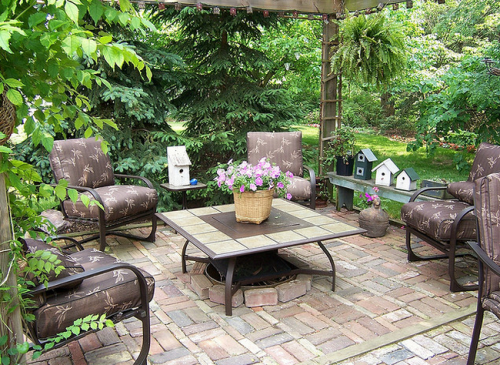
Conclusion
The arrangement of the patio in the country with your own hands has a number of advantages. This makes it possible to get an additional useful space that can be used for various purposes. In addition, the patio is a good alternative to the gazebo, and the technology of its construction is simpler.
Patio arrangement ideas on the video are presented below:

